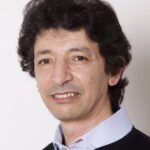Med Sci (Paris) 2009 ; 25 : 117–120
La cochlée, organe auditif des mammifères, tire sa sensibilité et sa sélectivité en fréquence de la présence des cellules ciliées externes (CCE). Ces cellules, qui n’existent que chez les mammifères, sont dotées d’électromotilité, c’est-à-dire que leur membrane plasmique latérale se contracte ou s’allonge en réponse à des modifications du champ électrique. C’est la prestine, une protéine intégrale de la membrane, qui confère aux CCE cette propriété. Le long de la paroi latérale, un treillis cortical hautement organisé, constitué d’actine et de spectrine, contribue également à ce processus. Nous venons de montrer que la sous-unité βV (et non l’isoforme βII) constitue, avec la sous-unité aII, la spectrine de la paroi des CCE, et qu’elle interagirait indirectement avec la prestine. La nature moléculaire du lien qui unit ces deux protéines reste à déterminer.

